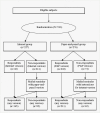Response rate and completeness of questionnaires: a randomized study of Internet versus paper-and-pencil versions
- PMID: 17942387
- PMCID: PMC2047288
- DOI: 10.2196/jmir.9.3.e25
Response rate and completeness of questionnaires: a randomized study of Internet versus paper-and-pencil versions
Abstract
Background: Research in quality of life traditionally relies on paper-and-pencil questionnaires. Easy access to the Internet has inspired a number of studies that use the Internet to collect questionnaire data. However, Internet-based data collection may differ from traditional methods with respect to response rate and data quality as well as the validity and reliability of the involved scales.
Objective: We used a randomized design to compare a paper-and-pencil questionnaire with an Internet version of the same questionnaire with respect to differences in response rate and completeness of data.
Methods: Women referred for mammography at a Danish public hospital from September 2004 to April 2005, aged less than 67 years and without a history of breast cancer, were eligible for the study. The women received the invitation to participate along with the usual letter from the Department of Radiology. A total of 533 women were invited to participate. They were randomized to receive either a paper questionnaire, with a prepaid return envelope, or a guideline on how to fill in the Internet-based version online. The questionnaire consisted of 17 pages with a total of 119 items, including the Short Form-36, Multidimensional Fatigue Inventory-20, Hospital Anxiety and Depression Scale, and questions regarding social status, education level, occupation, and access to the Internet. Nonrespondents received a postal reminder giving them the option of filling out the other version of the questionnaire.
Results: The response rate before the reminder was 17.9% for the Internet group compared to 73.2% for the paper-and-pencil group (risk difference 55.3%, P < .001). After the reminder, when the participant could chose between versions of the questionnaire, the total response rate for the Internet and paper-and-pencil group was 64.2% and 76.5%, respectively (risk difference 12.2%, P = .002). For the Internet version, 97.8% filled in a complete questionnaire without missing data, while 63.4% filled in a complete questionnaire for the paper-and-pencil version (risk difference 34.5%, P < .001).
Conclusions: The Internet version of the questionnaire was superior with respect to completeness of data, but the response rate in this population of unselected patients was low. The general population has yet to become more familiar with the Internet before an online survey can be the first choice of researchers, although it is worthwhile considering within selected populations of patients as it saves resources and provides more complete answers. An Internet version may be combined with the traditional version of a questionnaire, and in follow-up studies of patients it may be more feasible to offer Internet versions.
Conflict of interest statement
None declared.
Figures
Similar articles
-
Paper- or Web-Based Questionnaire Invitations as a Method for Data Collection: Cross-Sectional Comparative Study of Differences in Response Rate, Completeness of Data, and Financial Cost.J Med Internet Res. 2018 Jan 23;20(1):e24. doi: 10.2196/jmir.8353. J Med Internet Res. 2018. PMID: 29362206 Free PMC article.
-
Reliability of short form-36 in an Internet- and a pen-and-paper version.Inform Health Soc Care. 2009 Jan;34(1):53-8. doi: 10.1080/17538150902779527. Inform Health Soc Care. 2009. PMID: 19306199 Clinical Trial.
-
Internet versus mailed questionnaires: a randomized comparison.J Med Internet Res. 2004 Sep 15;6(3):e29. doi: 10.2196/jmir.6.3.e29. J Med Internet Res. 2004. PMID: 15471755 Free PMC article. Clinical Trial.
-
Electronic Data Capture Versus Conventional Data Collection Methods in Clinical Pain Studies: Systematic Review and Meta-Analysis.J Med Internet Res. 2020 Jun 16;22(6):e16480. doi: 10.2196/16480. J Med Internet Res. 2020. PMID: 32348259 Free PMC article.
-
Questionnaire surveys of dentists on radiology.Dentomaxillofac Radiol. 2012 May;41(4):267-75. doi: 10.1259/dmfr/58627082. Dentomaxillofac Radiol. 2012. PMID: 22517994 Free PMC article. Review.
Cited by
-
A Novel Digital Patient-Reported Outcome Platform for Head and Neck Oncology Patients-A Pilot Study.Clin Med Insights Ear Nose Throat. 2016 Sep 27;9:1-6. doi: 10.4137/CMENT.S40219. eCollection 2016. Clin Med Insights Ear Nose Throat. 2016. PMID: 27721662 Free PMC article.
-
Medical students' adoption and evaluation of a completely digital general practice clerkship - cross-sectional survey and cohort comparison with face-to-face teaching.Med Educ Online. 2022 Dec;27(1):2028334. doi: 10.1080/10872981.2022.2028334. Med Educ Online. 2022. PMID: 35107417 Free PMC article.
-
Fifteen Years' Use of Patient-Reported Outcome Measures at the Group and Patient Levels: Trend Analysis.J Med Internet Res. 2019 Sep 30;21(9):e15856. doi: 10.2196/15856. J Med Internet Res. 2019. PMID: 31573943 Free PMC article.
-
Electronic Health Record-Triggered Research Infrastructure Combining Real-world Electronic Health Record Data and Patient-Reported Outcomes to Detect Benefits, Risks, and Impact of Medication: Development Study.JMIR Med Inform. 2022 Mar 16;10(3):e33250. doi: 10.2196/33250. JMIR Med Inform. 2022. PMID: 35293877 Free PMC article.
-
Self-Reported Obsession Toward COVID-19 Preventive Measures Among Undergraduate Medical Students During the Early Phase of Pandemic in Jordan.Front Public Health. 2021 Nov 8;9:719668. doi: 10.3389/fpubh.2021.719668. eCollection 2021. Front Public Health. 2021. PMID: 34820347 Free PMC article.
References
-
- Jones R, Pitt N. Health surveys in the workplace: comparison of postal, email and World Wide Web methods. Occup Med (Lond) 1999 Nov;49(8):556–8. doi: 10.1093/occmed/49.8.556. http://occmed.oxfordjournals.org/cgi/pmidlookup?view=long&pmid=10658310 - DOI - PubMed
-
- Davis R N. Web-based administration of a personality questionnaire: comparison with traditional methods. Behav Res Methods Instrum Comput. 1999 Nov;31(4):572–7. - PubMed
Publication types
MeSH terms
LinkOut - more resources
Full Text Sources
Miscellaneous




